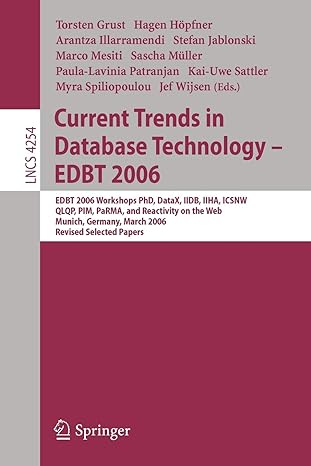Tables Created in Assignment 1 drop table paper_review cascade constraints; drop table reviewer cascade constraints; drop table paper_author cascade constraints; drop table paper cascade constraints;
Tables Created in Assignment 1
drop table paper_review cascade constraints;
drop table reviewer cascade constraints;
drop table paper_author cascade constraints;
drop table paper cascade constraints;
drop table editor cascade constraints;
drop table author cascade constraints;
create table author
(
aid int, -- author id
aname varchar(50), --- author name
aemail varchar(50), --- author email
affliation varchar(50),
primary key (aid));
insert into author values(1,'Dr. Chen','chen@umbc.edu','UMBC');
insert into author
values(2,'Susan','susan@umbc.edu','UMBC');
insert into author
values(3,'Steve','steve@umb.edu','UMB');
insert into author
values(4,'Carole','carole@umb.edu','UMB');
create table Editor
(
eid int, --- editor ID
ename varchar(50), --- editor name
eemail varchar(50), --- email
primary key (eid));
insert into editor
values(1,'Claire','claire g mail.com');
insert into editor
values(2,'David','david g mail.com');
create table paper(
pid int, -- paper id
title varchar(50),
eid int, -- assigned editor id
submit_date date, --- date of submission
status int, -- status: 1 accept, 2 under review, 3 revision, 4 reject
primary key(pid),
foreign key(eid) references editor);
--- accept
insert into paper values(1,'Comparing big data systems',2,date '2020-1-10',3);
-- under review
insert into paper values(2,'A novel approach of mining EHR data',2,date '2020-2-10',2);
--- revision,
insert into paper
values(3, 'A new SQL Benchmark', 1, date '2020-1-1',1);
create table paper_author (
pid int, -- paper id
aid, -- author id
primary key(pid,aid),
foreign key(pid) references paper,
foreign key(aid) references author);
insert into paper_author values(1,1);
insert into paper_author values(1,2);
insert into paper_author values(2,3);
insert into paper_author values(2,4);
insert into paper_author values(3,1);
insert into paper_author values(3,2);
create table Reviewer (
rid int, --- reviewer id
rname varchar(50), --- reviewer name
remail varchar(50), --- reviewer email
raffiliation varchar(50),
primary key(rid));
insert into reviewer values(1,
'Ellen','ellen g mail.com','Johns Hopkins');
insert into reviewer values(2,
'Cathy','cathy g mail.com','Johns Hopkins');
insert into reviewer values(3,
'Grace','grace g mail.com','Stanford');
insert into reviewer values(4,
'Eric','eric g mail.com','Stanford');
insert into reviewer values(5,
'Ethan','ethan@umbc.edu','UMBC');
create table paper_review (
prid int, -- paper review id
pid int, -- paper id
rid int, -- reviwer id
due_date date, -- review due date
receive_date date, -- review received date
round int, -- round of review, 1 means first round, 2 means second round, most paper will go through 2 rounds of review
decision int, -- 1 accept, 2 minor revision, 3 major revision, 4 reject
rcomment varchar(200), -- comments of review
primary key(prid),
foreign key(pid) references paper,
foreign key(rid) references reviewer);
-- paper 1, first round,
-- 2 major, 1 minor
insert into paper_review
values(1, 1, 1, date '2020-2-10',date '2020-2-9',
1,3,'Good paper but needs to improve writing');
insert into paper_review
values(2, 1, 3, date '2020-2-10',date '2020-2-10',
1,2,'Good paper fix a few typo');
insert into paper_review
values(3, 1, 4, date '2020-2-10',date '2020-2-12',
1,3,'Please add more experiments');
--- paper 2 is under review and no review provided.
insert into paper_review
values(4, 2, 2, date '2020-3-10',null,
1,null,null);
insert into paper_review
values(5, 2, 1, date '2020-3-10',null,
1,null,null);
insert into paper_review
values(6, 2, 3, date '2020-3-10',null,
1,null,null);
-- paper 3 has two rounds of reviews, r1: 1 major, 1 minor
-- r2: 2 accept
insert into paper_review
values(7, 3, 4, date '2020-2-1',date '2020-1-15',
1,2,'good paper, fix a few typo');
insert into paper_review
values(8, 3, 2, date '2020-2-1',date '2020-1-11',
1,3,'good paper, but please add more related work');
insert into paper_review
values(9, 3, 4, date '2020-3-1',date '2020-2-15',
2,1,'all comments addressed');
insert into paper_review
values(10, 3, 2, date '2020-3-1',date '2020-2-18',
2,1,'all comments addressed');
____________________________________________________________________
Suppose you have created tables in assignment 1. Please write an anonymous PL/SQL program for each the following problems. You can use the same code in assignment 2 to create the tables. Please include both your code and screenshots.
Problem 1: [30 points] Please write an anonymous PL/SQL program to print out the first 10 numbers of the following sequence F(n).
F(0) = 2, F(1)=5. F(n)=5*F(n-1)-4*F(n-2).
E.g., F(3) = 5*F(2) - 4 F(1) = 5*5-4*2=17, F(4)=5*F(3)-4*F(2)=5*17-4*5=65,
Your program will print out F(0),F(1),..., F(9).
Hint: use three variables, the first storing F(n), the second storing F(n-1), and the third storing F(n-2). Think of how to compute the first variable from the other two and how to update the other two variables in each iteration.
Problem 2: Write anonymous PL/SQL code to print out number of reviewers who have NOT submitted round 1 review for the paper titled 'A novel approach of mining EHR data'.
Hint: a review is not submitted if the receive_date column in paper_review table is null.
[30 points]
Problem 3: [40 points] Write an anonymous PL/SQL program to print out review decision and comments for round 1 review of paper titled 'Comparing big data systems'. In the same program, please also print out an automatic suggestion for this paper.
The suggestion should be 'reject' if at least two reviewers' decisions are
reject. The suggestion should be 'accept' if all reviewers' decisions are accept. All other cases the suggestion is 'to be decided by editor'.
Hint: you can use an explicit cursor to print out the review decision and comments, and a few implicit cursors to compute number of round 1 review for that paper, number of accept and number of reject decisions, and use if then else to come up with suggestion.
Step by Step Solution
There are 3 Steps involved in it
Step: 1

See step-by-step solutions with expert insights and AI powered tools for academic success
Step: 2

Step: 3

Ace Your Homework with AI
Get the answers you need in no time with our AI-driven, step-by-step assistance
Get Started


